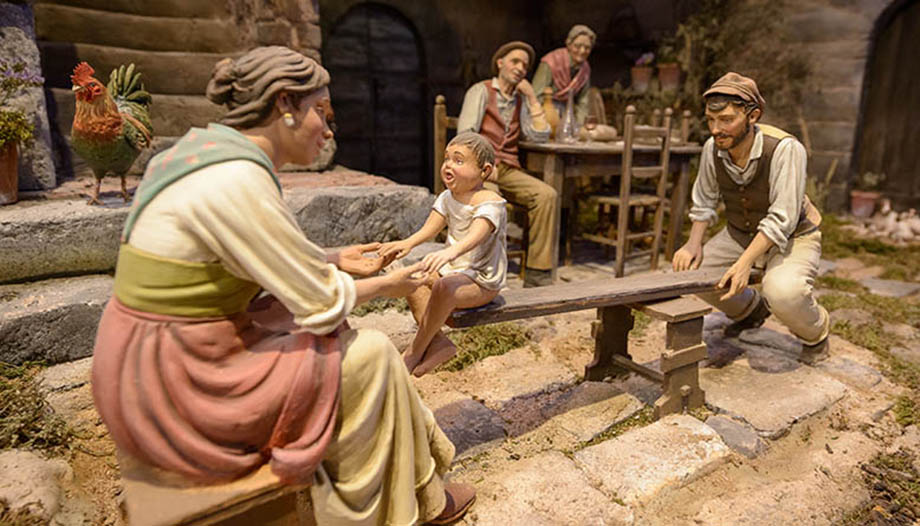In the middle of the Andalusian countryside lies the nativity scene museum largest in the world. Its location in the municipality of Mollina (Antequera, Malaga), of barely 5,000 inhabitants, is due to the birthplace of its promoters, Antonio Diaz and Ana Caballero. From a very young age, this couple took advantage of their trips around Spain to see the most characteristic nativity scenes of the regions they visited.
Their frequent contact with nativity scene makers accentuated their passion for the history and details of this very particular art, which blends sculpture, painting, architecture and lighting techniques. This hobby led them to gradually acquire numerous sets, until they finally brought them together in a museum that opened its doors in 2017.
The nativity scenes have been donated by the artists themselves and the most varied institutions, with the desire that the nativity scene heritage would not be lost and could be enjoyed by a wide audience. Nativity scenes are not a hobby that moves masses of people or large amounts of money, but since two years ago is officially Intangible Cultural Heritage of Spain.
History of the Museum
The Museo de Belenes de Mollina is a unique exhibition center of its kind. In a few years it has managed to become an essential destination for lovers of nativity scenes. More than 200,000 visitors have already passed through its halls, but it is still an undiscovered jewel for many people.
This ambitious project was awarded the Gold Medal of the International Federation of Nativity Scenes in 2023 and last year a congress of nativity scene makers was held with more than 800 participants.
The museum is open from Wednesday to Sunday, with extended hours in high season. Its entrance fee is very affordable and it organizes workshops and educational activities for children.
Museum data
The museum has more than 5,000 square meters, distributed in seven exhibition halls. The collection is growing steadily and currently exhibits more than 100 nativity scenes.
All the representations contain more than 7,000 unexpected figures of biblical scenes, framed in landscapes and contexts of different cultures, recreated with astonishing detail and realism.
One of the most striking aspects of the museum is the quality of the exhibition set-up, which includes very careful lighting, the protection of large armored glass for all the models and a very comfortable and spacious layout.
Surprising Nativity Scenes
The museum has a room with 20 dioramas, those little nativity scenes that show a scene with a great number of details, playing with mirrors and backgrounds that open up to other miniature spaces, offering the viewer a sensation of great depth and realism.
One of the most striking works is not a nativity scene, but a large circular model of 10 meters in diameter, which shows the main scenes of the Old and New Testament, with recreations of the main biblical passages of the history of salvation, from Adam and Eve to the Resurrection of Jesus.
The basements of the exhibition center also have a workshop where the figures and decorations of the models are arranged. As if all this were not enough, there are dozens of nativity scenes in storage that gradually renew the exhibition.
Varieties and sets
The museum houses several collections of cribs that are particularly noteworthy. First of all, there is a group of Neapolitan nativity scenes, very colorful and exuberant, set in 18th century Italy. Following a more popular, austere and close tradition, the collection has a group of Valencian nativity scenes.
Lovers of nativity scenes set in varied and original contexts will enjoy the scenes that are represented in other historical moments, current events or exotic places. For example, there are nativity scenes set in a slum in Rio de Janeiro, in the Roman theater of Cartagena, a street destroyed by war, the Patio de los Leones de la Alhambra or the cathedral of Burgos.
And, of course, the exhibition also includes nativity scenes by contemporary artists who reinterpret the nativity scene tradition, using innovative materials and techniques.
Easter
One of the most striking models of the exhibition represents the staging of the Passion of Christ. Andalusia cannot be understood without Holy Week, so no one is surprised that a nativity scene museum located in this region also has a representation of the Passion of Christ.
It is therefore perfectly natural that one of the exhibition rooms shows twelve dioramas with the entry of Christ into Jerusalem, the Last Supper, the washing of the feet, the kiss of Judas, the prayer of Jesus in the garden, the denials of Peter, the scourging, the trial before Pilate, the falls with the cross, the crucifixion, the descent from the cross and the resurrection. It is a set of scenes with figures by Angela Tripi.
Christmas 2024
For Christmas 2024, the museum has updated its catalog and has pieces that focus on the consequences of war conflicts, so topical, as the Ukraine war or the one that is lived in the Gaza or border areas between Israel and Lebanon. Thus, In war there is also hopeby Josep Font, located in the central hall, you can see the devastating effects of a bombing.
Also the diorama Way to freedom (Road to freedom), shows a Holy Family inspired by the flight to Egypt, although in this case fleeing from war and misery. A call to reflect on peace and the situation of many migrants.
The nativity scene is much more than a simple representation of the birth of Jesus. It is an art that has evolved over the centuries, adapting to different cultures and artistic styles. We owe the first known Nativity Scene to St. Francis of Assisi, who in 1223 celebrated Christmas Mass inside a cave in Italy.








